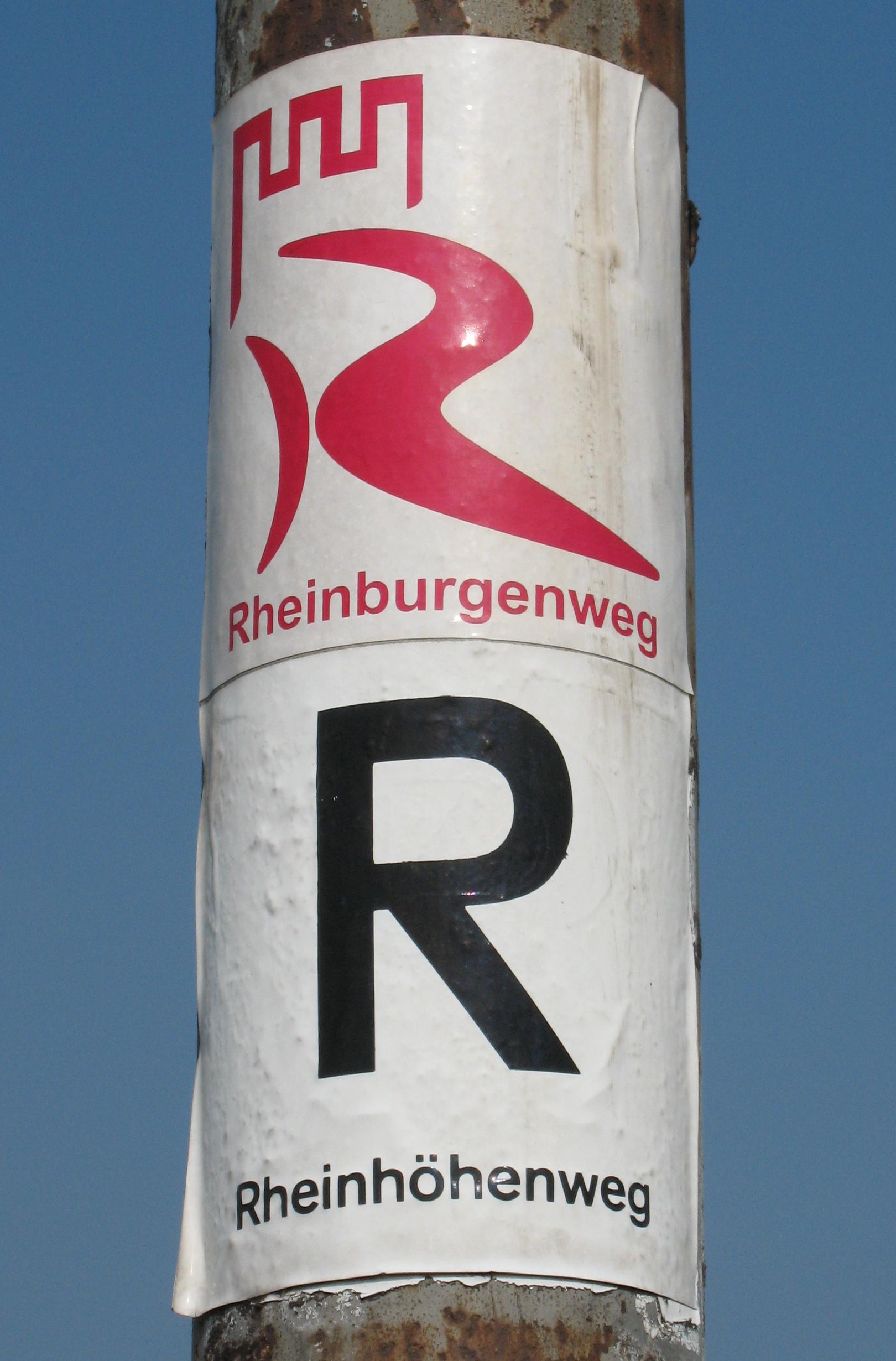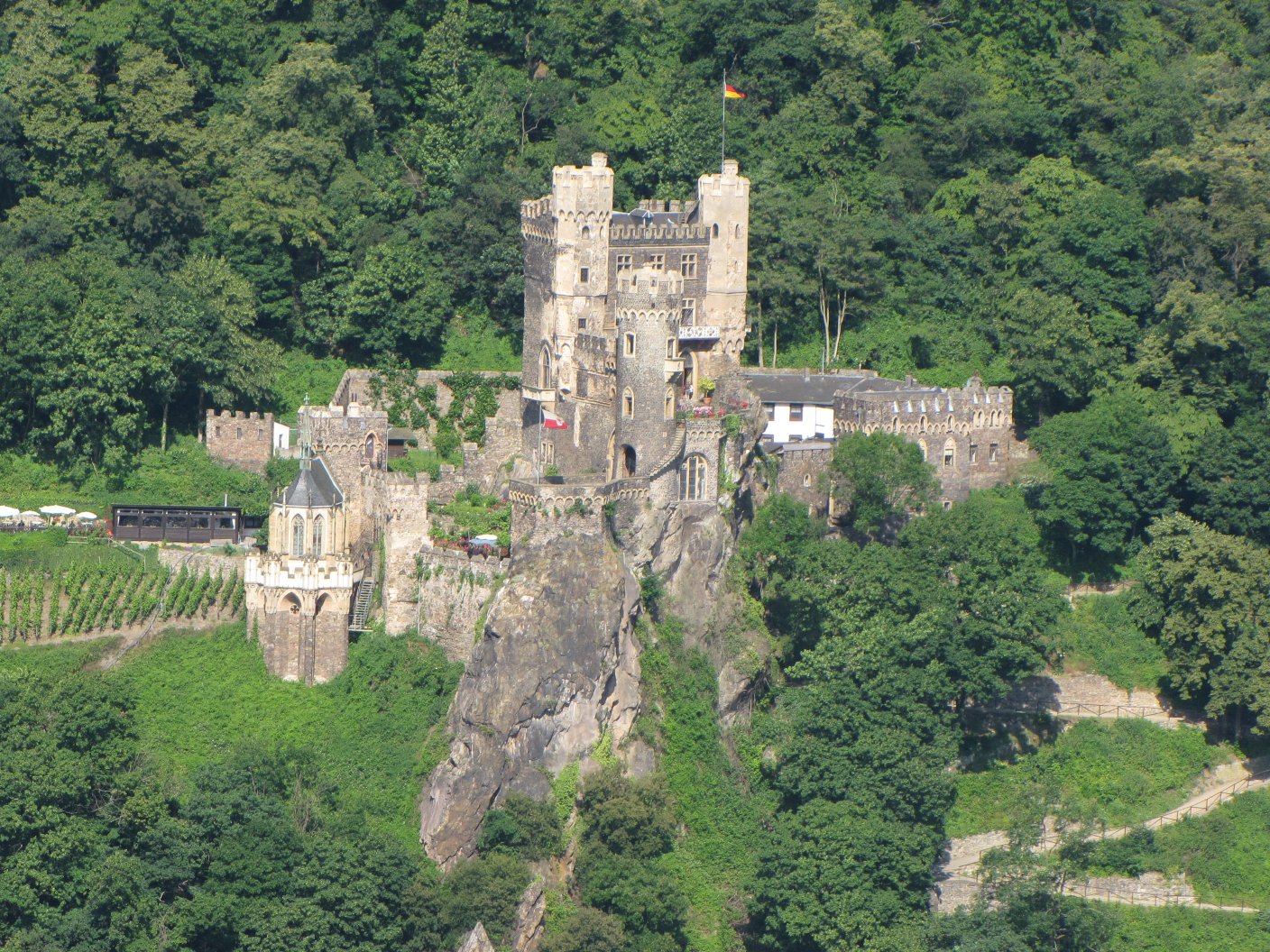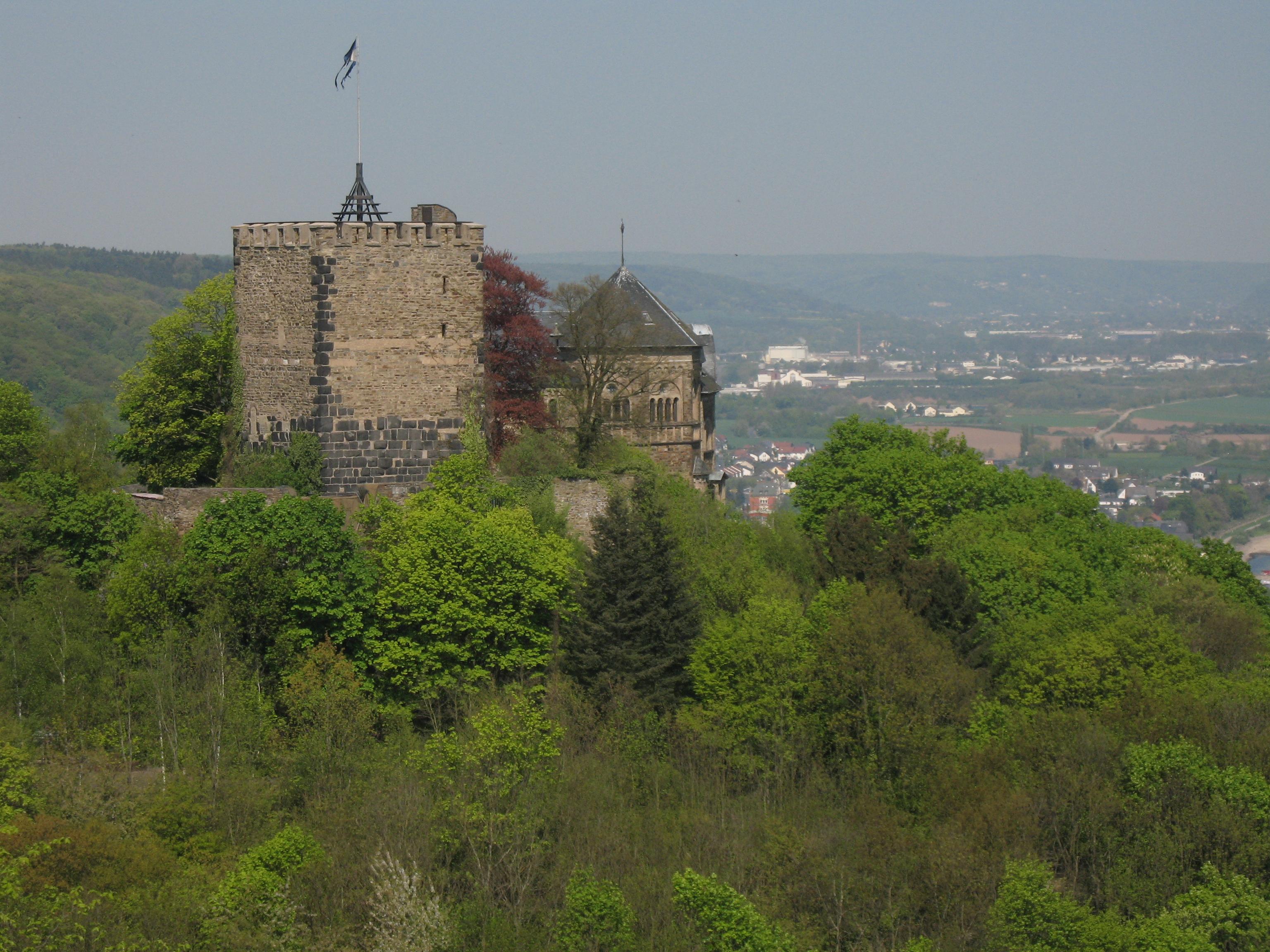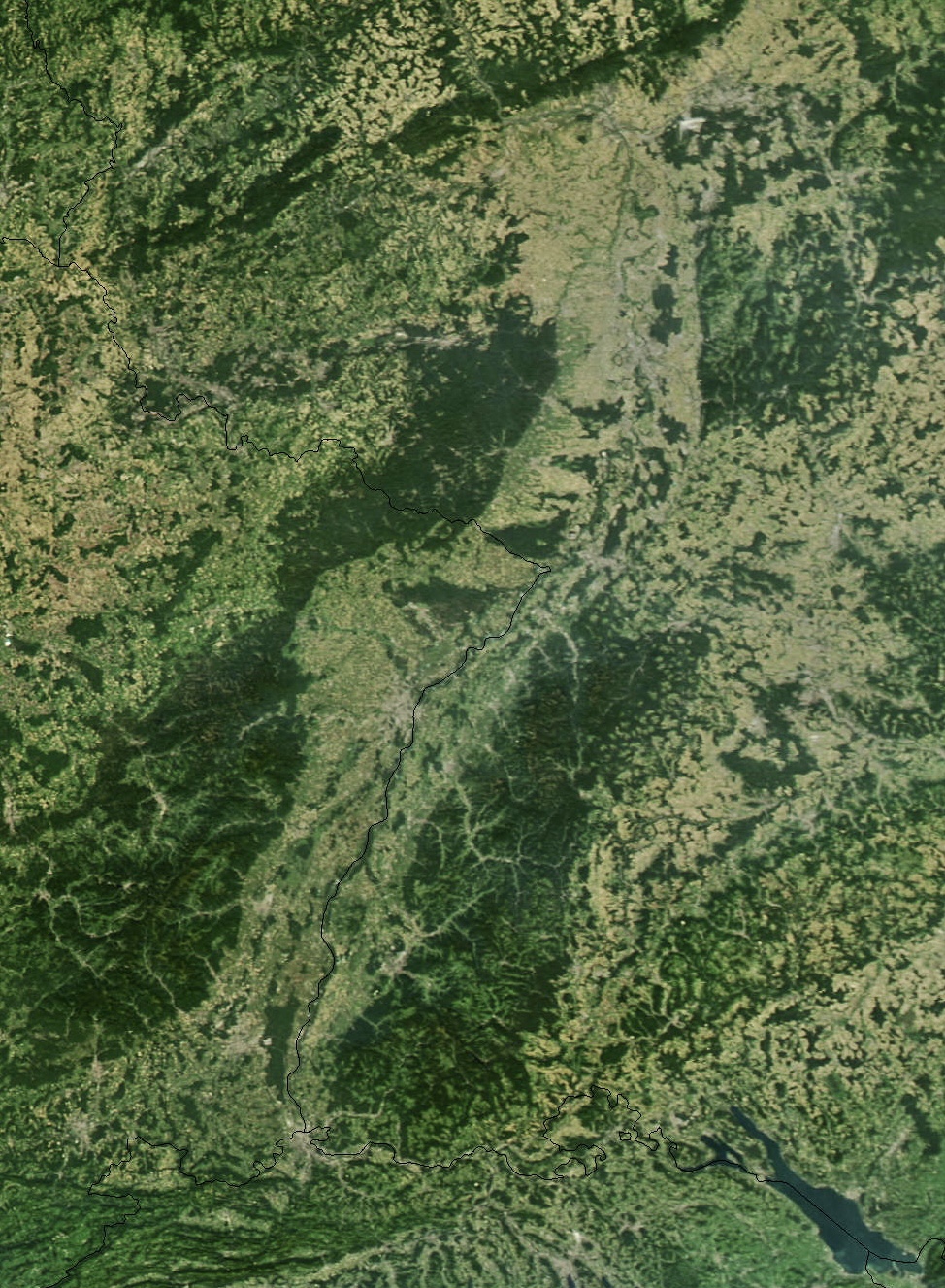|
Rheinhöhenweg Trail
The Rheinhöhenweg Trail is a popular hiking trail on the mountains of the Rhine Valley. It leads from the Lower Rhine in Bonn passing the Lorelei, Loreley up to the Upper Rhine. There is a Rheinhöhenweg Trail on both sides of the Rhine River. On the left side it goes from Bonn to Alsheim, which is to the south of Mainz, with a total length of 240 km. On the right side it goes from Bonn-Beuel to Wiesbaden with a total length of 272 km. Both trails together have a combined length of over 500 km. The Rheinhöhenweg Trail is marked by a black R on a white background. The trails on the left and on the right side are frequently connected by hiking trails called "Rheinhöhen Connection Trails", marked by the sign "RV". The Rheinhöhenweg Trail passes a vast number of famous castles like the Godesburg, Lahneck Castle, Stolzenfels Castle, Castle Rheineck, Rheinstein Castle, Drachenburg Palace and many others. External links Rheinhöhenweg trail*Rheinhöhenweg* ... [...More Info...] [...Related Items...] OR: [Wikipedia] [Google] [Baidu] |
Rheintaler Höhenweg
The Rheintaler Höhenweg, or Rhine valley high path, is a hiking trail along the western side of the Rhine valley in Switzerland. It starts in Rorschach, St. Gallen, Rorschach on the edge of Lake Constance, and follows the Rhine river southwards (upstream) through wine fields, fruit orchards and cheese-making countryside to finish in Sargans. The total route covers around , and reaches a maximum altitude of 1430 m (4700 feet). This route is not the same as the Rheinhöhenweg Trail, which is much further north, downstream in Germany. The route The route can be split up into several stages, for example: * From Rorschach to St. Margrethen * St. Margrethen to Altstätten * Altstätten to Sennwald * Sennwald to Wildhaus * Wildhaus to Malbun SG * Malbun to Sargans External links * http://www.wanderland.ch/en/routen_detail.cfm?id=317983 * http://www.wandersite.ch/Rheintal.html Hiking trails in Switzerland Sargans {{Switzerland-stub ... [...More Info...] [...Related Items...] OR: [Wikipedia] [Google] [Baidu] |
Lower Rhine
Lower Rhine (, ; kilometres 660 to 1,033 of the Rhine) is the section of the Rhine between Bonn in Germany and the North Sea at Hook of Holland in the Netherlands, including the '' Nederrijn'' () within the Rhine–Meuse–Scheldt delta; alternatively, ''Lower Rhine'' may also refer to just the part upstream of Pannerdens Kop ( km 660–865.5), excluding the ''Nederrijn''. It is the last of the four sections of the Rhine between Lake Constance and the North Sea (the others being the High Rhine, Upper Rhine and Middle Rhine). Geography German section Downstream of Bonn, the river meanders through the Lower Rhine Bay (), passing through the city of Cologne (), and continues through the Lower Rhine Plain (). The German term ''Niederrhein'' refers both to the German section of the Lower Rhine as well as to parts of the surrounding Lower Rhine region. Netherlands section Almost immediately after entering the Netherlands, the Rhine splits into numerous branches. The main branch ... [...More Info...] [...Related Items...] OR: [Wikipedia] [Google] [Baidu] |
Hiking Trails In Rhineland-Palatinate
A hike is a long, vigorous walk, usually on trails or footpaths in the countryside. Walking for pleasure developed in Europe during the eighteenth century. Long hikes as part of a religious pilgrimage have existed for a much longer time. "Hiking" is the preferred term in Canada and the United States; the term "walking" is used in these regions for shorter, particularly urban walks. In the United Kingdom and Ireland, the word "walking" describes all forms of walking, whether it is a walk in the park or backpacking in the Alps. The word hiking is also often used in the UK, along with rambling, hillwalking, and fell walking (a term mostly used for hillwalking in northern England). The term bushwalking is endemic to Australia, having been adopted by the Sydney Bush Walkers Club in 1927. In New Zealand a long, vigorous walk or hike is called tramping. It is a popular activity with numerous hiking organizations worldwide, and studies suggest that all forms of walking have health ben ... [...More Info...] [...Related Items...] OR: [Wikipedia] [Google] [Baidu] |
Drachenburg Palace
Schloss Drachenburg or Drachenburg Castle is a private villa styled as a palace and constructed in the late 19th century. It was completed in only two years (1882–84) on the Drachenfels hill in Königswinter, a German town on the east bank of the Rhine, south of the city of Bonn. Baron (1833–1902), a broker and banker, planned to live there, but never did. The villa is owned by the State Foundation of North Rhine-Westphalia. It is served by an intermediate station on the Drachenfels Railway. History Stephan Sarter was born in Bonn and, after leaving school, was apprenticed to the Leopold Seligman bank in Köln. He transferred to the Salomon Openheim bank, ending up as a market analyst in their Paris branch. Trading on his own account, he amassed a fortune and applied for a patent of nobility in 1881. He continued to live in Paris for the rest of his life, but commissioned the ''schloss'' as a fitting background for a German baron. The initial plans for the building were d ... [...More Info...] [...Related Items...] OR: [Wikipedia] [Google] [Baidu] |
Rheinstein Castle
Rheinstein Castle () is a castle near the town of Trechtingshausen in Rhineland-Palatinate, Germany. History The castle was constructed in about 1316/1317. Rheinstein Castle was important for its strategic location. By 1344, the castle was in decline. By the time of the Palatine War of Succession, the castle was very dilapidated. During the romantic period in the 19th century, Prince Frederick of Prussia (1794–1863) bought the castle and it was rebuilt. Description Burg Rheinstein possesses a working drawbridge and portcullis, which are typical of medieval castle architecture and defences. The castle is open to the public. Just past the gift shop near the entrance is an opening on the left to the courtyard, which has views of the Rhine. Rheinstein's courtyard is known as the Burgundy Garden after the Burgundy grape vine growing there. The vine, which is approximately 500 years old, still produces grapes. From the garden, steps lead down to the castle chapel. In the ce ... [...More Info...] [...Related Items...] OR: [Wikipedia] [Google] [Baidu] |
Castle Rheineck
Bad Breisig () is a town in the district of Ahrweiler, in Rhineland-Palatinate, Germany. It is situated on the Rhine, approx. 15 km south-east of Bad Neuenahr-Ahrweiler. Bad Breisig is the seat of the ''Verbandsgemeinde'' ("collective municipality") Bad Breisig. Personalities Sons and daughters of the town * Beate Berger (1886-1940), director of the Jewish children's home '' Beith Ahawah '' in Berlin and Haifa People connected with Bad Breisig * Max Barthel (1893-1975), working poet, lived from 1948 to 1969 in Bad Breisig * Klaus Badelt (born 1967), a German composer, which specializes in television and soundtrack. * Kai Krause (born 1957), a German musician and software - pioneer, lives in . * The religious scholar and sociologist Oliver Krüger Oliver Krüger (born 1973) is a German professor in Religious studies at the University of Fribourg (Switzerland). From 1994 to 1999 he studied sociology, classical archaeology, and comparative religion at the Universit ... [...More Info...] [...Related Items...] OR: [Wikipedia] [Google] [Baidu] |
Lahneck Castle
Lahneck Castle (German: Burg Lahneck) is a medieval fortress located in the city of Lahnstein in Rhineland-Palatinate, Germany, south of Koblenz. The 13th-century castle stands on a steep rock salient above the confluence of the Lahn River with the Rhine, opposite Stolzenfels Castle, in the district of Oberlahnstein. Its symmetrical plan, an oblong rectangle, is typical of the later castles of the time of the Hohenstaufen. The pentagonal shape of the bergfried is rare for castle towers. The castle became well known in Britain by the death of Idilia Dubb in June 1851. While on holiday with her family, the 17-year-old girl mounted the abandoned castle's high tower, when suddenly the wooden stairs collapsed behind her. Nobody heard her crying and calling from the tower, because it was surrounded by an insurmountable wall, 3 meters high. The last entry in her diary: “All I know is that there is no hope for me. My death is certain ..'Father in heaven, have mercy on my soul'.” She ... [...More Info...] [...Related Items...] OR: [Wikipedia] [Google] [Baidu] |
Godesburg
300px, Godesburg castle in Germany. The Godesburg is a castle in Bad Godesberg, a formerly independent part of Bonn, Germany. Built in the early 13th century on the Godesberg, a hill of volcanic origin, it was largely destroyed following a siege in 1583 at the start of the Cologne War. In 1891, the German emperor Wilhelm II donated the castle's ruin to the city of Bad Godesberg. In 1959, the ruin was rebuilt according to plans by Gottfried Böhm, to house a hotel and restaurant. Today, the restaurant is still in operation, but the hotel tract has been divided into apartments. Location The site has a controversial history. Growing out of the nineteenth-century ''Heimat'' movement, historians speculated that in the pre-Christian era, the inhabitants probably used the peak to call to the god ''Wotan'', the god of war, death and the hunt, and other attributes, establishing a custom that led eventually to the erection of a house of prayer on the site. They found early mention of ... [...More Info...] [...Related Items...] OR: [Wikipedia] [Google] [Baidu] |
Mainz
Mainz (; #Names and etymology, see below) is the capital and largest city of the German state of Rhineland-Palatinate, and with around 223,000 inhabitants, it is List of cities in Germany by population, Germany's 35th-largest city. It lies in the Frankfurt Rhine-Main, Rhine-Main Metropolitan Region—Germany's second-largest metropolitan region after Rhine-Ruhr—which also encompasses the cities of Frankfurt am Main, Wiesbaden, Darmstadt, Offenbach am Main, and Hanau. Mainz is located at the northern end of the Upper Rhine Plain, on the left bank of the Rhine. It is the largest city of Rhenish Hesse, a region of Rhineland-Palatinate that was historically part of Grand Duchy of Hesse, Hesse, and is Rheinhessen (wine region), one of Germany's most important wine regions because of its mild climate. Mainz is connected to Frankfurt am Main by the Rhine-Main S-Bahn rapid transit system. Before 1945, Mainz had six boroughs on the other side of the Rhine (see: :de:Rechtsrheinische St ... [...More Info...] [...Related Items...] OR: [Wikipedia] [Google] [Baidu] |
Upper Rhine
Upper Rhine ( ; ; kilometres 167 to 529 of the Rhine) is the section of the Rhine between the Middle Bridge, Basel, Middle Bridge in Basel, Switzerland, and the Rhine knee in Bingen am Rhein, Bingen, Germany. It is surrounded by the Upper Rhine Plain (). Most of its upper section marks the France–Germany border. The Upper Rhine is one of four sections of the river (the others being the High Rhine, Middle Rhine and Lower Rhine) between Lake Constance and the North Sea. The countries and states along the Upper Rhine are Switzerland, France (Alsace) and the German states of Baden-Württemberg, Rhineland-Palatinate and Hesse. The largest cities along the river are Basel, Mulhouse, Strasbourg, Karlsruhe, Mannheim, Ludwigshafen and Mainz. The Upper Rhine was River engineering, straightened between 1817 and 1876 by Johann Gottfried Tulla and made Navigability, navigable between 1928 and 1977. The Treaty of Versailles allows France to use the Upper Rhine for hydroelectricity in the Gra ... [...More Info...] [...Related Items...] OR: [Wikipedia] [Google] [Baidu] |
Lorelei
The Lorelei ( ; or , or ; also found as ''Loreleï'', ''Lore Lay'', ''Lore-Ley'', ''Lurley'', ''Lurelei'' and ''Lurlei'' throughout history) is a , steep slate rock on the right bank of the River Rhine in the Rhine Gorge (or Middle Rhine) at Sankt Goarshausen in Germany, part of the Upper Middle Rhine Valley UNESCO World Heritage Site. The 1930s Loreley Amphitheatre is on top of the rock. It has been an infamous fluvial disaster site since its first records during the 10th century, with a varied mythos, ranging from dwarfs to a siren trying to explain the high number of ship wrecks and the loud echo inside the passage. Etymology The name comes from the old German words , Rhine dialect for "murmuring", and the Old German term "rock". The translation of the name would therefore be "murmur rock" or "murmuring rock". The heavy currents, and a small waterfall in the area (still visible in the early 19th century) created a murmuring sound, and this combined with the spec ... [...More Info...] [...Related Items...] OR: [Wikipedia] [Google] [Baidu] |









